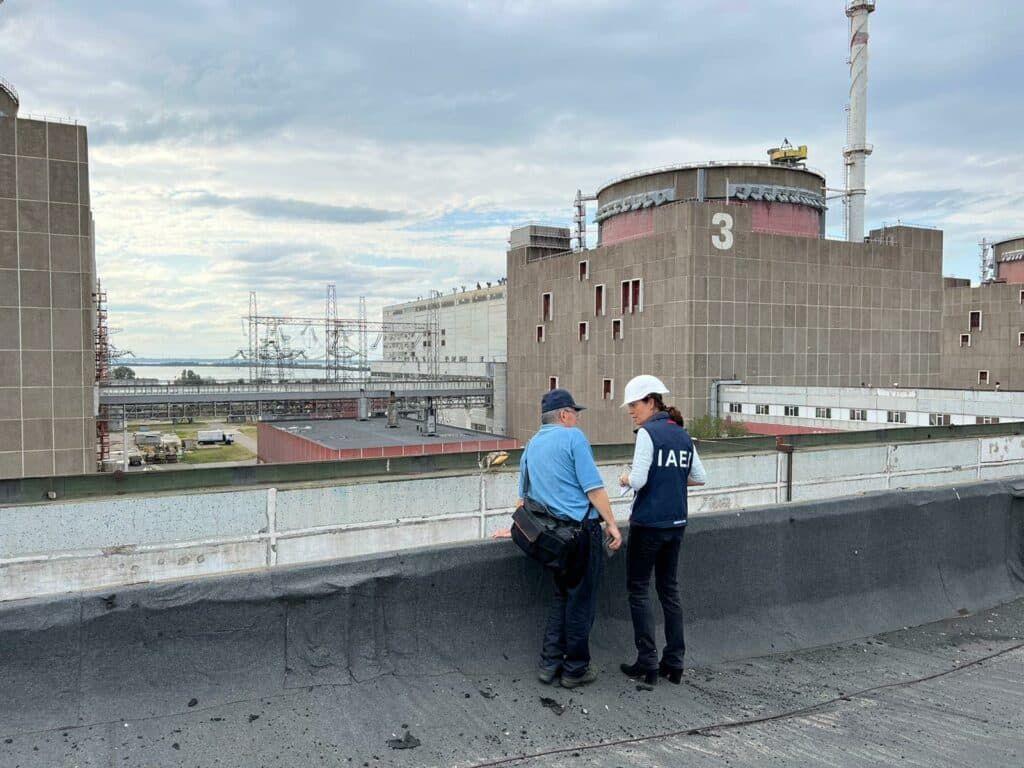IAEA arrives at the Zaporizhzhia nuclear power plant for its riskiest mission in history
By François Diaz-Maurin | September 2, 2022
 The IAEA Support and Assistance Mission to Zaporizhzhya (ISAMZ) arrived at the Zaporizhzhia nuclear power plant in Ukraine on September 1, 2022. The mission comprised IAEA nuclear safety, security, and safeguards staff. (Photo credit: D. Candano Laris/IAEA)
The IAEA Support and Assistance Mission to Zaporizhzhya (ISAMZ) arrived at the Zaporizhzhia nuclear power plant in Ukraine on September 1, 2022. The mission comprised IAEA nuclear safety, security, and safeguards staff. (Photo credit: D. Candano Laris/IAEA)
On Thursday, experts of the International Atomic Energy Agency (IAEA), the UN’s nuclear watchdog, reached the Zaporizhzhia nuclear power plant in southern Ukraine for what is the riskiest mission of the agency’s history. Shortly before departing for the plant from Kyiv, IAEA Director General Rafael Mariano Grossi told journalists: “We are aware of the current situation. There has been increased military activity, including a few minutes ago. But weighing the pros and cons, and having come so far, we are not stopping.” Wearing a blue bulletproof vest stamped “United Nations,” Grossi added: “We are moving now, accepting the risks are very, very high,” commenting ahead of their trip across the front line.
The Zaporizhzhia nuclear power plant, the largest in Europe, was seized by Russian forces in March and has since then raised fears of a nuclear accident due to a power outage, human error, or military mistake. On August 25, the plant was temporarily disconnected from the power grid after fires caused by shelling cut the last power line connecting the plant to Ukraine’s grid system. The incident forced the automatic shutdown of reactors 5 and 6 and triggered the emergency diesel generators to maintain the cooling of the reactor core and spent fuel pools and prevent a nuclear accident. It was the first time in nearly 40 years of operation that the Zaporizhzhia nuclear power plant has been disconnected from the grid.
On Thursday morning—only hours before IAEA experts headed to Zaporizhzhia—the plant was forced again to trigger emergency systems, shutting down reactor 5 after shelling struck a 330-kV backup power line.
The mission comes after a month-long of intense negotiations and pressure by the international community to have Russia and Ukraine let an IAEA mission inspect the plant’s physical integrity, staff conditions, and safety and security systems. Earlier this August, a Russian diplomat said that it was too dangerous for an IAEA mission to pass through the capital city of Kyiv. But on August 23, the UN’s Security Council announced that it had gathered the necessary logistics and security capabilities to support an IAEA mission to the Zaporizhzhia plant from Kyiv, provided Russia and Ukraine agree. On Monday, Grossi announced that he would lead such a mission.
Officially called IAEA Support and Assistance Mission to Zaporizhzhya (ISAMZ), the effort consists of a 14-member team of nuclear safety, security, and safeguards staff, including IAEA’s chief. “We have a very important mission to accomplish,” Grossi said on Thursday. It was not clear however what the experts would be looking at during their mission. Earlier on that day, Grossi commented that he and his team of experts will work on “a detailed analysis of some of the more technical aspects,” without specifying what those aspects were.
Another doubt concerned the extent of the IAEA’s mission. Russia reportedly has been hiding heavy military equipment at the plant’s premises. It was not clear whether experts would be allowed to inspect all buildings. In photos of the visit released by the IAEA, Grossi and the other mission members are seen taking notes as they tour the facility and talking to employees of Energoatom, Ukraine’s state nuclear company. There was no sign of Russian troops or military equipment. In one picture, IAEA staff are seen next to what is believed to be an emergency diesel generator, like those triggered on the same day.
After his visit, Grossi said: “It is obvious the physical integrity of the plant has been violated, several times. This is a reality that cannot continue to happen.” But it is not clear how the IAEA can help reduce the risk of a nuclear accident. The agency has no authority to order a cease-fire or create a demilitarized zone.
On Thursday afternoon, Grossi tweeted, as he was completing his first visit, that the IAEA will stay and establish a permanent presence at the plant. “We are not going anywhere. The IAEA is now there, it is at the plant and it is not moving,” Grossi said after he returned to Ukrainian-held territory.
Together, we make the world safer.
The Bulletin elevates expert voices above the noise. But as an independent nonprofit organization, our operations depend on the support of readers like you. Help us continue to deliver quality journalism that holds leaders accountable. Your support of our work at any level is important. In return, we promise our coverage will be understandable, influential, vigilant, solution-oriented, and fair-minded. Together we can make a difference.
Keywords: IAEA, Russia, Russia-Ukraine, Ukraine, Zaporizhzhia, Zaporizhzhia nuclear power plant, nuclear accidents, shelling
Topics: Nuclear Energy, Nuclear Risk














